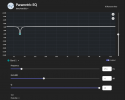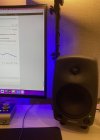Since my last measurements, I have changed my preamp and altered the gain structure setup for my equalizer. And I am trying to do things a bit more carefully.
Here's the setup: Dayton Audio calibration mic into Presonus Studio 24c (both mic and interface have been calibrated, the latter with a loopback test) into a line input on my B&K MC-101 Sonata preamp. On the preamp, the line amp is engaged, the tone controls are defeated, and the EQ loop is engaged. The PEQ is a Yamaha YDP2006 digital parametric equalizer from a couple of decades ago. The Yamaha equalizer provides six parametric filters for each channel, with +/- 12 dB of gain, and a Q range of 1-10, plus low and high shelf filters. Each channel also includes six notch filters, of which two can be reconfigured as low and high-pass filters. It also include pre-emphasis to hot-rod the high frequencies going into the processor, which I have turned off. The DSP portion includes an internal in-and-out converters comprising 20-bit Burr-Brown PCM1760P ADC and a PCM63P DAC clocked at 44.1 KHz. Analog gain amps are provided by common 5532 op-amps. This equalizer has good specs for its day--distortion better than -80 dB, noise likewise, and a dynamic range of 106 dB. In a playback chain, this isn't terrible, though the specs won't look as good as one of the better miniDSP models, and I have sort-of poked around what those units would require (in dollars) to make a real improvement.
The output of the B&K preamp is fed to a pair of B&K Reference 125.2 amplifiers driving Revel Concerta F12 speakers in a biwire arrangement that does nothing but let me use both of the amps I own. (The amps will be replaced with an incoming Buckeye NC502MP amp in the search for more power and also just because.
Obviously, REW isn't going to attempt to support that Yamaha commercial PEQ directly. I do wish that they would provide a configurable equalizer, rather than a (long) list of more current models. Being able to program the number and type of filters would at least minimize the back-and-forth required to get REW not to suggest more filters than I have.
So, to the measurements. I have used the "psychoacoustic" smoothing, because my purpose isn't looking at comb filtering but rather identifying what PEQ filters I need. And with 1/12 smoothing, the EQ algorithm in REW asked for many more filters than the Yamaha provides.
Before:
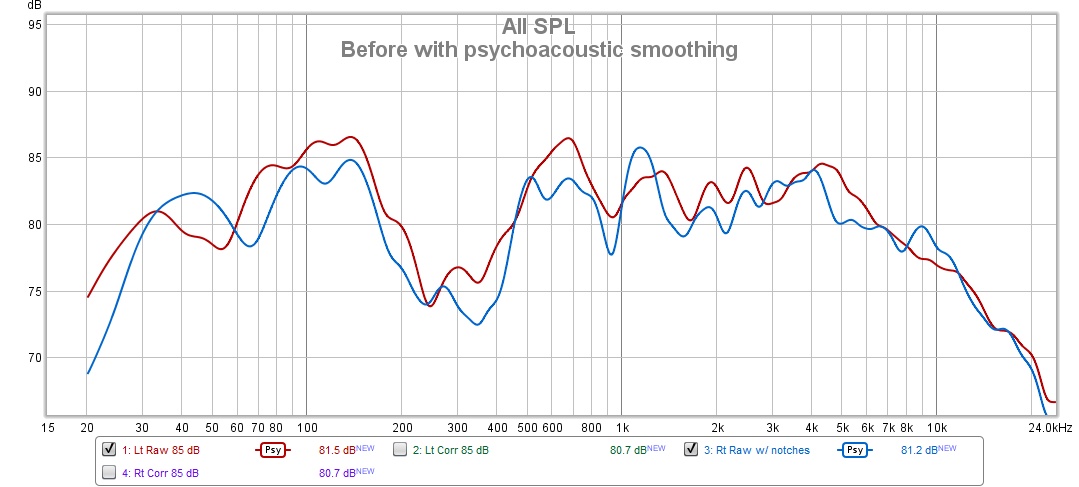
I used the equalizer feature to attempt to match a target with a low-frequency cutoff of 25 Hz and a 0.6 dB/octave downward tilt from there up. REW distinguishes the bass range from everything else, so I had to define around the 200-Hz boundary it defines. I have to say that my room is not very intense on first reflections, so I'm not thinking the stronger downward tilt of the Harman model would be exactly right in this room. So I've gone a bit flatter, which fits my preference in any case.
I gave REW the range of up to 1000 Hz, recognizing that the changes I wanted to see at 900 Hz were probably not minimum phase.
The big hole at 200-400 Hz troubles me. It's well below the crossover between the woofers and mid-range driver, which is at 575 Hz, so I don't think it's a suckout. I see big spikes in excess group delay at 240, 325, 353, and 425 Hz, but I'm still trying to sort out in my head what all that actually means. I think it means not trying to fix the dip in that region with narrow filters. But there's something happening in the room to cause that issue--the anechoic response of these speakers doesn't show it.
Here are the PEQ corrections I made:
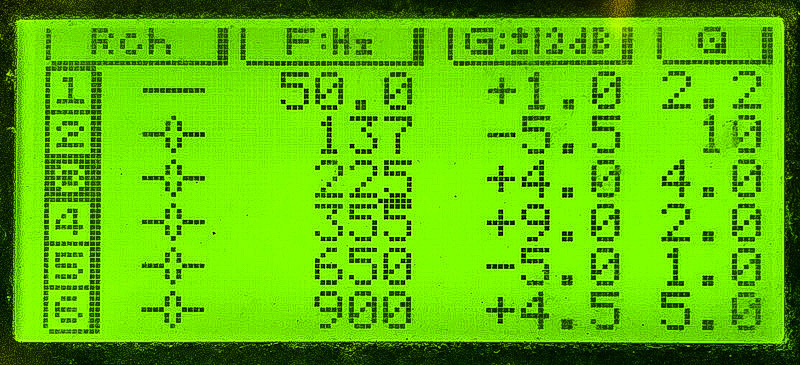
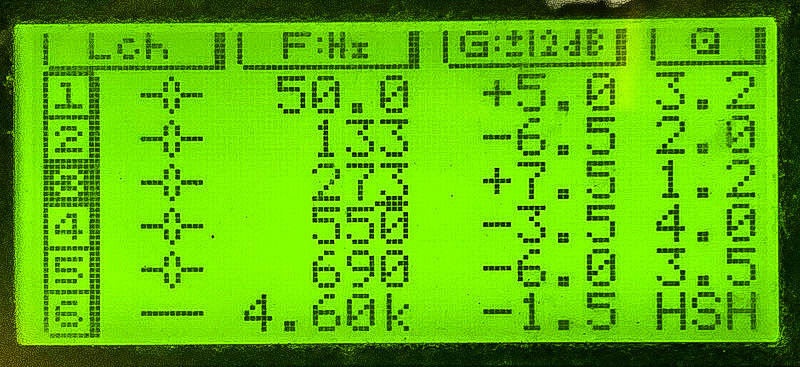
Note that Filter 1 on the right channel is switched out, as is Filter 6 on the left channel. The Q range goes to 10, but I have no idea what the numbers mean, or how they compared to the Q values used in REW for the "Generic" equalizer. I kept the numbers fairly low to keep the filter shapes broad, in the (ignorant) hope that it will work around those frequencies that see excess group delay.
Filling that gap requires a LOT of gain in the equalizer. I cannot for a moment consider dropping everything else in the band. But I did substantially attenuate the signal so that with the equalizer looped in by the preamp. the overall loudness noticeably decreases. I should measure some levels with my SSVM to determine where I can set those values to avoid clipping the return input of the preamp (which is upstream of the line stage). I did notice more distortion in the REW plot than I have seen before, with lots of regions above 1% coming out of the speakers. I can't hear a problem, but that doesn't mean it isn't there. So, there's more to do. I'm not worried about starving the amp--I'm already at full input capability of the amp halfway up the volume pot of the preamp.
Here's the response with the EQ corrections:
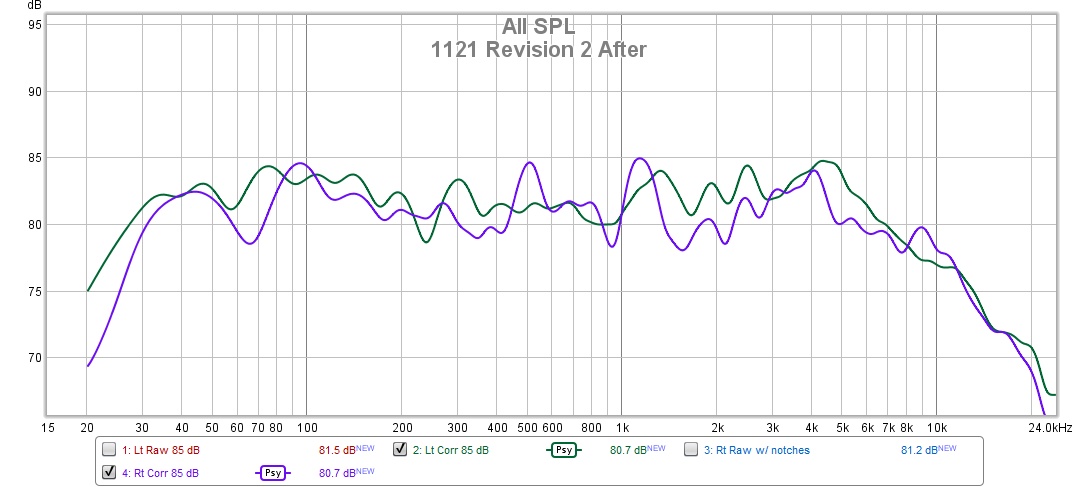
I cannot explain the rolloff in the top octave. I always see it, but it's not the microphone, which was provided with a calibration file that shows little correction up there. I know the speakers are capable up to 20 KHz, but I don't know what in my room might be sucking them up. That's on the list to fully understand. Not that I can hear much up there.
And there's a bump at 3-4 KHz that I did not mess with--a trim at that point should make the whole graph acquire that obvious downward spectral tilt. I still have an open filter on each channel if I decide I can mess with it.
Rick "still on the steep part of the learning curve, it seems" Denney
Your filters are looking good, but I would suggest you skip the 900Hz filter on the right channel and 4.6kHz filter on the left channel as this is above room influence range so not covered accurateky by your emasurement.

